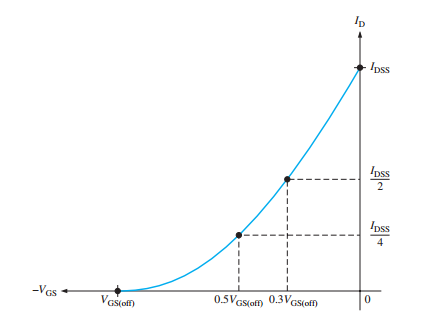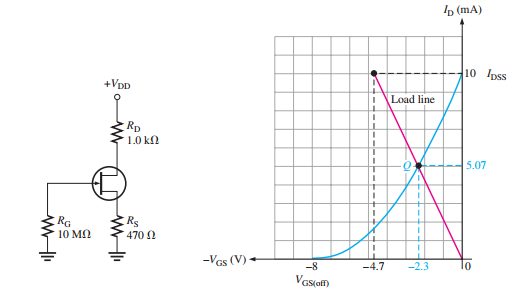Field-effect transistor (FET)s
Introduction
Transistors are essential semiconductor devices.
Two major types:
Bipolar Junction Transistor (BJT)
Field-Effect Transistor (FET)
BJTs use both electrons and holes (bipolar)
FETs use only one type of charge carrier (unipolar).
What is a Field-Effect Transistor (FET)?
A voltage-controlled semiconductor device.
Controls current flow using an electric field.
Two main types:
Junction Field-Effect Transistor (JFET)
Metal-Oxide Semiconductor Field-Effect Transistor (MOSFET)
BJT vs. FET
| Feature | BJT | FET |
|---|---|---|
| Charge Carriers | Electrons & Holes (Bipolar) | Electrons or Holes (Unipolar) |
| Control Mechanism | Current-Controlled | Voltage-Controlled |
| Input Impedance | Low | High |
| Switching Speed | Slower | Faster |
| Preferred Applications | Amplifiers | Switching & High Impedance Circuits |
Junction Field-Effect Transistor (JFET)
Consists of three terminals: Gate, Source, and Drain.
Operates with reverse-biased pn junction to control current in a channel.
Two types based on channel structure:
N-channel JFET: Current flows through an n-type channel.
P-channel JFET: Current flows through a p-type channel.
High input impedance, making it useful in high-impedance amplifiers.

Basic Operation of JFET
Reverse-biased gate-source junction controls current flow.
\(V_{DD}\) provides drain-to-source voltage, allowing current flow from drain to source.
\(V_{GG}\) sets reverse-bias voltage, producing a depletion region along the pn junction.
The depletion region controls channel width and resistance.
Wider depletion region towards the drain end due to greater reverse-bias voltage.

JFET Characteristics and Parameters
Voltage-Controlled Device: JFET operates as a voltage-controlled, constant-current device.
Drain Characteristic Curve:
\(I_D\) increases with \(V_{DS}\) initially (Ohmic region) but becomes constant in the active region.
Pinch-off voltage (\(V_p\)) is where \(I_D\) becomes constant.

Breakdown Region:
Occurs when \(I_D\) increases rapidly beyond safe limits.
JFET must be operated below breakdown voltage.
\(V_{GS}\) Controls \(I_D\):
Increasing negative \(V_{GS}\) reduces \(I_D\) due to narrowing of the channel.
The cutoff voltage (\(V_{GS}\text{(off)}\)) is where \(I_D\) is approximately zero.
For an n-channel JFET, the more negative \(V_{GS}\) is, the smaller \(I_D\) becomes.
\(V_{GS}\)(off) and \(V_p\) are equal in magnitude but opposite in sign.

JFET Universal Transfer Characteristic
Transfer characteristic curve: \(V_{GS}\) and \(I_{D}\) relationship.
Also known as the transconductance curve.
Key characteristics:
\(I_{D} = 0\) when \(V_{GS} = V_{GS(off)}\)
\(I_{D} = I_{DSS}\) at \(V_{GS} = 0\)
\(I_{D}\) follows a square-law relationship:
\(I_{D}\) can be determined for any \(V_{GS}\) if \(V_{GS(off)}\) and \(I_{DSS}\) are given.

An example of how the transfer characteristic curve (blue) of an n-channel JFET is developed from the JFET drain characteristic curves (green).

JFET Forward Transconductance
- \[\begin{aligned} g_m & = \frac{\Delta I_D}{\Delta V_{GS}} \\ g_m & = g_{m0} \left(1 - \frac{V_{GS}}{V_{GS(off)}} \right)\\ g_{m0} &\Rightarrow~ \text{transconductance at}~ V_{GS} = 0 \end{aligned}\]\(\Delta V_{GS}\)\(\Delta I_D\)Forward Transconductance (g\(_m\)):
- \[g_{m0} = \frac{2 I_{DSS}}{|V_{GS(off)}|}\]is unknown, it can be estimated as: When

JFET has high input resistance (\(R_{IN}\)) due to reverse-biased gate-source junction.
\[R_{IN} = \left| \frac{V_{GS}}{I_{GSS}} \right|\]Input Capacitance (C\(_{iss}\)): Results from the reverse-biased pn junction.
AC Drain-to-Source Resistance (r\(_{ds}'\)): Resistance in the active region where \(I_D\) remains constant over a range of \(V_{DS}\).
\[r_{ds}' = \frac{\Delta V_{DS}}{\Delta I_D}\]Often specified in terms of output conductance \(g_{os}\).
JFET Biasing
The purpose of biasing is to set a proper Q-point.
Three types of biasing in the active region:
Self-bias
Voltage-divider bias
Current-source bias
Self-Biasing
Ensures gate-source junction is reverse-biased.
\[\begin{aligned} V_{GS} &= -I_D R_S \Leftarrow \text{n-channel JFET}\\ V_{GS} &= +I_D R_S \Leftarrow \text{p-channel JFET} \end{aligned}\]\[\begin{aligned} \text{drain voltage}~V_D & = V_{DD} - I_D R_D \\ \text{drain-to-source voltage}~ V_{DS} & = V_{DD} - I_D (R_D + R_S) \\ \text{required source resistance}~R_S & = \left| \frac{V_{GS}}{I_D} \right| \end{aligned}\]Biasing at the midpoint allows maximum current swing.
- \[V_{GS} = V_{GS(\text{off})}/3.4\], the gate-source voltage is: When
The Q-point is determined by plotting the load line.
- \[V_{GS} = -I_D R_S\]The load line equation:
Intersection of load line and transfer characteristic gives \(I_D\) and \(V_{GS}\).

Voltage-Divider Bias
Current-Source Bias
Purpose: Increase Q-point stability by making \(I_\mathrm{D}\) independent of \(V_\mathrm{GS}\).
Method: constant-current source in series with the JFET source.
- \[I_\mathrm{E} = \frac{V_\mathrm{EE} - V_\mathrm{BE}}{R_\mathrm{E}} \approx \frac{V_\mathrm{EE}}{R_\mathrm{E}}\]\(V_\mathrm{EE} \gg V_\mathrm{BE}\)\(I_\mathrm{E}\)Implementation
Result: \(I_\mathrm{D}\) remains constant across all transfer characteristic curves.

Ohmic Region in JFET Characteristics
Ohmic Region: Ohm’s law applies.
Behavior: JFET acts as a variable resistor.
Control: Resistance depends on \(V_{GS}\).
Extent: From origin to active region breakpoint.
Curves: Nearly constant slope for small \(I_D\).
Slope and Conductance
The slope of the characteristic curve is related to the dc drain-to-source conductance \(G_{DS}\):
\[\text{Slope} = G_{DS} \cong \dfrac{I_D}{V_{DS}}\]The dc drain-to-source resistance is:
\[R_{DS} = \dfrac{1}{G_{DS}} \cong \dfrac{V_{DS}}{I_D}\]
Biasing in the Ohmic Region
A JFET can be biased in either the active or ohmic region.
When biased in the ohmic region, the JFET is equivalent to a resistance.
When biased in the active region, the JFET is equivalent to a current source.
To bias in the ohmic region, the dc load line must intersect the characteristic curve.
For example, setting the dc saturation current:
- \[\text{Decrease in slope} \implies \text{Less } I_D, \text{ More } V_{DS} \implies \text{Increase in } R_{DS}\]As Q-point moves along the load line, slope decreases, leading to:
This allows voltage-controlled resistance.

